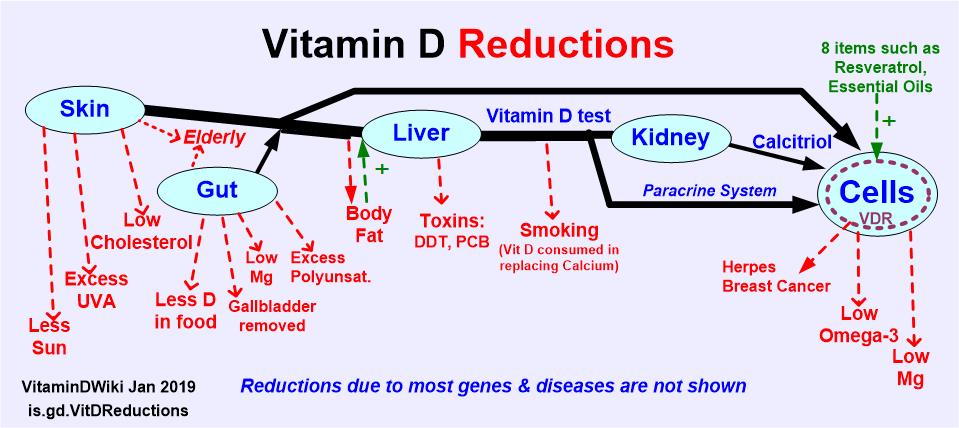Resveratol helps vitamin D bind to cells
Resveratrol Potentiates Vitamin D and Nuclear Receptor Signaling - Dec 2014
Journal of Cellular Biochemistry, DOI: 10.1002/jcb.25070
Angelika Dampf-Stone1,‡, Shane Batie1,2,‡, Marya Sabir1,‡, Elizabeth T. Jacobs3,4, Jamie H. Lee1, G. Kerr Whitfield2, Mark R. Haussler2 and Peter W. Jurutka1,2, pjurutka@asu.edu
1 School of Mathematical and Natural Sciences, Arizona State University, Glendale, AZ 85306
2 Department of Basic Medical Sciences, The University of Arizona, College of Medicine, Phoenix, AZ, 85004
3 University of Arizona Cancer Center, Tucson AZ, 85724
4 Mel and Enid Zuckerman College of Public Health, University of Arizona, Tucson, AZ, 85724
The 1,25-dihydroxyvitamin D3 (1,25D) hormone is derived from vitamin D generated in skin or obtained from the diet, and binds to and activates the vitamin D receptor (VDR) in target tissues including kidney, colon/small intestine, and bone/muscle.
We tested resveratrol for its ability to modulate VDR signaling, using vitamin D responsive element (VDRE) and mammalian two-hybrid (M2H) transcriptional system technology. Via VDRE-based assays in kidney, colon and myoblast cells, VDR-mediated transcription was activated by resveratrol, and a cooperative effect on transactivation was observed with resveratrol plus 1,25D. The M2H assay revealed a modest, resveratrol-induced dimerization of VDR with its retinoid X receptor (RXR) heteropartner.
Cells treated with both resveratrol and 1,25D displayed synergistic stimulation of VDR-RXR heterodimerization, while resveratrol antagonized rexinoid-mediated RXR-RXR homodimerization. Increased transactivation in response to resveratrol was also observed with a subset of other nuclear receptors and their respective cognate responsive elements.
Evaluation of wild-type versus a ligand-binding domain mutant VDR revealed that hormone-responsiveness to 1,25D was severely depressed, while the response to resveratrol was only moderately attenuated.
Moreover, radiolabeled 1,25D-displacement assays demonstrated an increase in VDR-bound 1,25D in the presence of resveratrol.
Thus, resveratrol may affect VDR and other nuclear receptors indirectly, likely via the ability of resveratrol to:
1) potentiate 1,25D binding to VDR,
2) activate RXR, and/or 3) stimulate SIRT1, an enzyme known to deacetylate nuclear receptors.
The results of this study elucidate a possible pathway for crosstalk between two nutritionally derived lipids, vitamin D and resveratrol, both of which converge on VDR signaling.
📄 Download the PDF from sci-hub via VitaminDWiki
41 studies referenced this study as of July 2021
Regulation of resveratrol biosynthesis in grapevine: new approaches for disease resistance? - 2019
Effects of resveratrol on bone health in type 2 diabetic patients. A double-blind randomized-controlled trial - 2018
Biological effects of combined resveratrol and vitamin D3 on ovarian tissue - 2017
Biological Effects of Vitamin D3 Mediated by the Interaction with VDR in Different Tissues
EFFECTS OF RESVERATROL AND QUERCETIN ON VITAMIN D METABOLIZING CYTOCHROME P450 ENZYMES - 2016
See also VitaminDWiki
Resveratrol category has items along with related searches
Resveratrol improves health (Vitamin D receptor, etc.) - many studies
Immune system improvement by vitamin D is boosted by resveratrol and blueberries – Sept 2013
Vitamin D and Resveratrol reduce weight gain in rats - Sept 2011
Resveratrol gets vitamin D to cells even if poor vitamin D receptor
Decrease of Alzheimer’s biomarker halted by Resveratrol (perhaps due to vitamin D) – RCT Sept 2015
Bone density improved with resveratrol (which improves Vitamin D Receptor) – RCT Sept 2018
VitaminDWiki updated the following chart due to this and previous Resveratrol studies

See also web
Health Benefits and Molecular Mechanisms of Resveratrol: A Narrative Review - March 2020
- Extensive 📄 PDF
Top 16 Benefits of Resveratrol Self Hacked Dec 2018
- Typically 5 mg/kg of body weight = 400 mg
Resveratrol supplementation, where are we now and where should we go? - May 2015
Huge amount of variabiity in how much each person needs.
Vitamin D Receptor is not mentioned
Search PubMed for Resveratrol "vitamin D receptor" 649 items as of July 2021
Nanotechnology-based formulations for resveratrol delivery: Effects on resveratrol in vivo bioavailability and bioactivity - Aug 2019 https://doi.org/10.1016/j.colsurfb.2019.04.030
2020 Top Resveratrol Supplements Guide: What To Avoid Society Health
- Does not appear to consider bio-availability
Resveratrol Can Help Repair Skin Damage Mercola July 2021
Title change caused the visitor count to reset.
There have actually been visitors to this page since it was originally made
